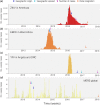Reconstruction and prediction of viral disease epidemics
- PMID: 30394230
- PMCID: PMC6398585
- DOI: 10.1017/S0950268818002881
Reconstruction and prediction of viral disease epidemics
Abstract
A growing number of infectious pathogens are spreading among geographic regions. Some pathogens that were previously not considered to pose a general threat to human health have emerged at regional and global scales, such as Zika and Ebola Virus Disease. Other pathogens, such as yellow fever virus, were previously thought to be under control but have recently re-emerged, causing new challenges to public health organisations. A wide array of new modelling techniques, aided by increased computing capabilities, novel diagnostic tools, and the increased speed and availability of genomic sequencing allow researchers to identify new pathogens more rapidly, assess the likelihood of geographic spread, and quantify the speed of human-to-human transmission. Despite some initial successes in predicting the spread of acute viral infections, the practicalities and sustainability of such approaches will need to be evaluated in the context of public health responses.
Keywords: Geographic spread; real-time prediction; viral epidemics.
Figures

Comment in
-
Letter to the editor in response to 'Reconstruction and prediction of viral disease epidemics'.Epidemiol Infect. 2019 Jan;147:e98. doi: 10.1017/S095026881900013X. Epidemiol Infect. 2019. PMID: 30869030 Free PMC article. No abstract available.
References
-
- Ministerio da Saude (Brazil) (2018) http://portalarquivos2.saude.gov.br/images/pdf/2018/janeiro/30/af-inform....
Grants and funding
LinkOut - more resources
Full Text Sources

